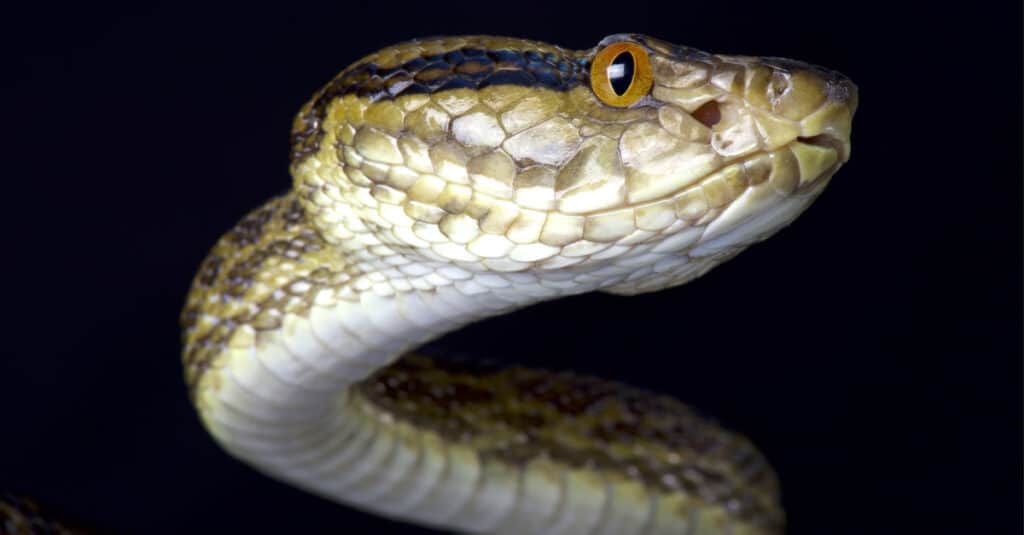Habu Snake
.jumbotron {
background-image: url(“https://a-z-animals.com/media/2022/04/Habu-Snake-400×300.jpg”);
}
}
@media only screen and (min-width: 641px) and (max-width: 920px) {
.jumbotron {
background-image: url(“https://a-z-animals.com/media/2022/04/Habu-Snake-470×370.jpg”);
}
}
@media only screen and (min-width: 921px) {
.jumbotron {
background-image: url(“https://a-z-animals.com/media/2022/04/Habu-Snake.jpg”);
}
}
Habu Snake
Protobothrops flavoiridis
Unlike most pit vipers, the Habu gives birth to live young.
Habu Snake Scientific Classification
- Kingdom
- Animalia
- Phylum
- Chordata
- Class
- Reptilia
- Order
- Squamata
- Family
- Viperidae
- Genus
- Protobothrops or Trimeresurus
- Scientific Name
- Protobothrops flavoiridis
Read our Complete Guide to Classification of Animals.
Habu Snake Conservation Status
Habu Snake Facts
- Prey
- Small mammals, snakes, frogs, and birds
- Name Of Young
- Snakelets or neonates
- Fun Fact
- Unlike most pit vipers, the Habu gives birth to live young.
- Estimated Population Size
- Unknown
- Other Name(s)
- Okinawa Habu, Kume Shima Habu
- Temperament
- Aggressive
- Litter Size
- 1 – 18 snakelets
- Habitat
- The transitional zone between cultivated fields and palm forests
- Diet
- Carnivore
- Favorite Food
- Mice and rats
- Common Name
- Habu Snake
- Average Clutch Size
- 1
This post may contain affiliate links to our partners like Chewy, Amazon, and others. Purchasing through these helps us further the A-Z Animals mission to educate about the world’s species..

Discover alligator-eating snakes, spiders larger than your phone, and 1000 more incredible animals in our daily FREE email.
.photo-gallery {
–margin: 0px auto 0px;
–padding: 0px 0px 0px 0px;
}
.gallery-link {
background-image: url(“https://a-z-animals.com/media/2022/04/Habu-shu-sake-1024×535.jpg”);
background-repeat: no-repeat;
background-size: cover;
background-position: center;
height: 500px;
justify-content: center;
text-align: center;
align-items: center;
display: flex;
border: 2px solid #000;
}
.gallery-link img {
height: 50%;
}
@media only screen and (max-width: 768px) {
.gallery-link {
height: 300px !important;
}
}
View all of the Habu Snake images!
The Habu Snake is most famous for its use in “medicinal” habu sake (habushu), or snake wine.
The Habu Snake, also called the Kume Shima or Okinawa Habu, is a venomous snake from Japan. Though not usually fatal, it has a bite that can cause serious injury. Habu snake numbers are decreasing, perhaps due to habitat loss and overhunting. It is just one species of Japanese snake used in the making of snake wine.
4 Amazing Facts
- Habu snakes are used in making snake wine. Sometimes, the snakes have been known to revive (and bite!) after fermenting in the wine for months!
- These snakes are pit vipers, similar to the much-feared fer-de-lance of South America.
- Habu snakes can only be found on a small group of islands in Japan.
- Unlike most pit vipers, the Habu gives birth to live young.
Where to Find the Habu Snake
These snakes have a very limited range, living on the islands of Okinawa, Amami, Amakarima Island, Kerama-Retto Island, and Okinawajima Island, of the Ryuku Archipelago in Japan.
button.pulse {
transform: scale(1); animation: pulse 2s infinite;
box-shadow: 0 0 0 0 rgba(11, 247, 25, 1);
}
@keyframes pulse {
0% { transform: scale(0.90); box-shadow: 0 0 0 0 rgba(11, 247, 25, 0.5); }
60% { transform: scale(1); box-shadow: 0 0 0 15px rgba(11, 247, 25, 0); }
100% { transform: scale(0.90); box-shadow: 0 0 0 0 rgba(11, 247, 25, 0); }
}
If you want to see one of these snakes in the wild, look for it on the larger volcanic islands in this region, where it is relatively common. It is generally not found on the smaller coral islands.
Its favorite habitat is in the transitional zone between cultivated fields and palm forests. You may also see one of these snakes if you visit old tombs, caves, or structures with rock walls.
Sadly, the most common place that people may spot these snakes is in marketplaces highly trafficked by tourists. These snakes are no longer living, however – they have been used to create habu sake, or snake wine, a supposedly medicinal drink with a whole snake coiled in the bottle. Though snake wine has been made and used for centuries, its sales have recently increased. Why? Because tourists want to take home the fearsome-looking snake in a bottle.
Scientific Name
The Habu Snake has several common names, including Okinawa Habu and Kume Shima. It also has several scientific names. Most often, it is listed as Protobothrops flavoviridis. Other sources list it as Trimeresurus flavoviridis. Both classifications indicate its relationship to other pit vipers. The Latin flavoviridis means “yellowish green” and describes the snake’s color. It is of the class Reptilia (reptiles) and the family Viperidae (viper snakes).
Historically, scientists have struggled to class the Habu Snake effectively. Other scientific name synonyms include Bothrops flavoviridis, Trimeresurus riukiuanus, and Lachesis flavoviridis.
In the past, two subspecies were recognized – P. flavoviridis tinkhami and P. flavoviridis flavoviridis.
Population & Conservation Status
The total population of these snakes is unknown, but researchers believe that the population is in decline. One reason is an observable decrease in the number of bites each year. On Okinawajima Island, around 300 people were bitten by these snakes each year in 1970. By the 1990s, 100 were bitten each year. In 2015, fewer than 30 bites occurred.
The pattern is similar on Amamaioshima Island, where 300 bites per year in 1950 dropped to less than 100 bites per year by 2000.
The Habu is currently rated as an animal of Least Concern by the IUCN Red List of Threatened Species. This rating was assigned in 2016.
How To Identify the Habu Snake: Appearance and Description
The Habu Snake is a large pit viper; in fact, it is the largest snake in its genus. Its average length is 4 to 5 feet, but individuals 7.9 feet in length have been observed.
This snake has a large head and a slender body. Its scales are small. Its background color is brown or olive green, with dark green or darker brown blotches on top. The edges of the blotches are yellow, and yellow spots may also occur. Often, the blotches fuse to form a wavy line down the back. The snake’s belly is white with dark edges.
How to Identify Habu Snakes
- 4 to 5 feet in length
- Blotchy olive green or brown pattern
- White belly edged in darker colors

reptiles4all/Shutterstock.com
Habu Snake Venom: How Dangerous Are They?
The venom of the Habu Snake is highly toxic. It contains hemorrhagic components and cytotoxins. The bite causes symptoms such as nausea, vomiting, and hypotension (low blood pressure).
People do not usually die from Habu Snake bites. However, if you are bitten, you should seek medical care immediately. Even after receiving treatment, 6 to 8 percent of bite victims suffer permanent disability, losing motor function in the hands or legs due to the venom’s effects.
Habu Snake Behavior and Humans
These snakes are aggressive when disturbed, resulting in a relatively high number of snake bites. Decades ago, hundreds of people were bitten by Habu Snakes each year. Today the numbers are lower – about 2 bites per 1,000 people. However, this rate is still considered very high.
People may encounter Habu snakes when visiting cemeteries or historic structures, as the snakes like to rest along rock walls. People may also be bitten if they step on the snake, as it is a terrestrial or ground-dwelling species. Bites are more likely to occur at night since the snake is nocturnal. It may enter homes in search of food sources, namely mice or rats.
View all 72 animals that start with H
Habu Snake FAQs (Frequently Asked Questions)
Are Habu Snakes Venomous?
Yes, Habu Snakes are venomous. They are pit vipers. Their venom contains cytotoxin and hemorrhagic components. Habu Snake bites can cause death or disability.
How Do Habu Snakes Hunt?
As pit vipers, Habu Snakes have heat-detecting pits on their faces. They use these to sense the body heat of birds and mammals. This is especially helpful for this nocturnal snake. It hunts at night, so it can not rely on its vision in the low light.
When the Habu Snake finds prey, it strikes quickly. This snake has a long reach compared to other snakes. Once bitten, the venom kills the small animals. After they cease to struggle, the snake can swallow them safely.
Are Habu Snakes Aggressive?
Yes, Habu Snakes are considered aggressive. Habu Snakes bites occur at a high rate compared to other snake species.
Where Do Habu Snakes Live?
Habu Snakes live in Japan, specifically on the islands of Ryukyu, which includes Okinawa and the Amami Islands. They like rock walls and the edges of forests and cultivated fields.
What Do Habu Snakes Eat?
Habu Snakes hunt small mammals, including rats and mice, as well as birds, frogs, and other reptiles.
How Venomous Is a Habu Snake?
Most bites from Habu Snakes are not deadly. However, the venom is destructive. It causes nausea, vomiting, and low blood pressure. A small percentage of people permanently lose the ability to control the movements of their hands and legs.
Is the Habu Snake Endangered?
The Habu Snake is not currently considered endangered. However, its population has been in decline at least since the 1970s. People collect the snake for use in habushu or snake wine, and it may be overhunted. Additionally, the small Asian mongoose, a well-known snake predator, was introduced to Okinawa in 1910 specifically for the purpose of reducing Habu Snake populations.
Can You Buy Habu Snakes in the US?
Occasionally, online retailers or international importers sell habu sake in the United States. Travelers may also bring habushu back to the States with them. Snake wine itself is not illegal there.
However, not all snake wine will be permitted to enter the country. It depends on the type of snake used to make the habushu. If the Habu Snake was used, it will be permitted, since it is not considered an endangered species. Others, like those made from the king cobra, will be confiscated as an illegal import of an endangered species.
Sources
- BBC, Available here: https://www.bbc.com/travel/article/20151113-the-wine-that-comes-with-added-bite
- Atlas Obscura, Available here: https://www.atlasobscura.com/foods/snake-wine-china-vietnam
- IUCN Redlist, Available here: https://www.iucnredlist.org/species/96265495/96265515
















